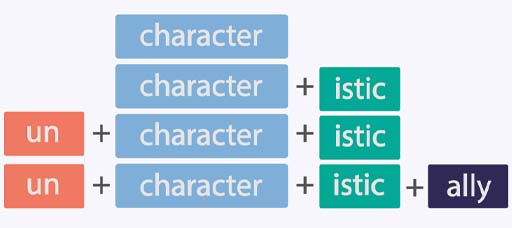4.2 Adding more morphemes
Words can quickly increase in size once more morphemes are added. Here is a diagram showing how the free morpheme character (9 letters long) adds three bound morphemes to become uncharacteristically (20 letters long).
Activity 6 Show me the morphemes
Take a look at the examples below, each of which contains a new word made by combining morphemes in novel ways. First, identify which is the new word. Then break it down into its morphemes, before finally thinking about why the writer might have used this word and what effect it has on you as the reader. Do you know what each new word means?
- We just had another nonversation stood at the bus stop.
Discussion
Nonversation: The bound morpheme non- (as in nonrefundable) is added to conversation (which is itself formed by adding the bound morphemes -ate and -ion to the free morpheme converse). In fact non- replaces the con- at the start of conversation. The result is a word that means a conversation where nothing much is said (i.e. small talk).
- Snickers: Get a degree in Snackonomics (Walsh, 2009)
Discussion
Two free morphemes snack and economic have been used here with the bound morpheme -s (snack + economic + s) to create a (supposed) new field of academic study. Snackonomics appeared on a printed advertisement for a chocolate bar that was being promoted on university campuses.
- I’m quite good at spelling, but I’m so unkeyboardinated
Discussion
The new word unkeyboardinated can be defined as ‘the inability to type on a computer keyboard without making mistakes’. It is a combination of the free morpheme keyboard (which has itself developed from key + board, but most people probably now think of this as its own word – indeed, it has its own entry in most dictionaries) plus the prefix un- and the two suffixes -inate and -ed. It has a comic effect because it sounds similar to uncoordinated which likely helped you to unpack its meaning.
- He’s always on his mobile phone; he’s just so cellfish.
Discussion
This final example is a combination of two free morphemes cell (as in a mobile phone) and fish. The resulting word sounds like selfish and indeed it is supposed to mean someone who rudely ignores others because they are spending too much time on their mobile phone.
This activity shows that, even if you’re not sure what a word means, and even if it’s a brand-new word, you can often still identify its morphemes. This ability probably helped you work out more or less what the new words in the examples meant. In fact advertisers who create new words rely on this ability. Using morphemes to create new words like this is just one way we can get creative with language.

